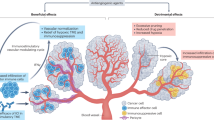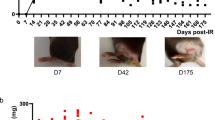Abstract
Isolated limb perfusion (ILP) with tumour necrosis factor alpha (TNF-alpha) and melphalan has shown impressive results in patients with irresectable soft tissue sarcomas and stage III melanoma of the extremities. The mechanisms of the reported in vivo synergistic anti-tumour effects of TNF-alpha and melphalan are not precisely understood. We have developed an ILP model in the rat using a non-immunogenic sarcoma in which similar in vivo synergy is observed. The aim of this present study was to analyse the morphological substrate for this synergistic response of TNF-alpha in combination with melphalan to shed more light on the pathomechanisms involved. Histology of the tumours from saline- (n = 14) and melphalan-treated (n = 11) rats revealed apparently vital tumour cells in over 80% of the cross-sections. Interstitial oedema and coagulation necrosis were observed in the remaining part of the tumour. Haemorrhage was virtually absent. TNF-alpha (n = 22) induced marked oedema, hyperaemia, vascular congestion, extravasation of erythrocytes and haemorrhagic necrosis (20-60% of the cross-sections). Oedema and haemorrhage suggested drastic alterations of permeability and integrity of the microvasculature. Using light and electron-microscopy, we observed that haemorrhage preceded generalised platelet aggregation. Therefore, we suggest that the observed platelet aggregation was the result of the microvascular damage rather than its initiator. Remarkably, these events hardly influenced tumour growth. However, perfusion with the combination of TNF-alpha and melphalan (n = 24) showed more extensive haemorrhagic necrosis (80-90% of the cross-sections) and revealed a prolonged remission (mean 11 days) in comparison with the other groups of rats. Electron microscopical analysis revealed similar findings as described after TNF-alpha alone, although the effects were more prominent at all time points after perfusion. In conclusion, our findings suggest that the enhanced anti-tumour effect after the combination of TNF-alpha with melphalan results from potentiation of the TNF-alpha-induced vascular changes accompanied by increased vascular permeability and platelet aggregation. This may result in additive cytotoxicity or inhibition of growth of residual tumour cells.
This is a preview of subscription content, access via your institution
Access options
Subscribe to this journal
Receive 24 print issues and online access
$259.00 per year
only $10.79 per issue
Buy this article
- Purchase on Springer Link
- Instant access to full article PDF
Prices may be subject to local taxes which are calculated during checkout
Similar content being viewed by others
Author information
Authors and Affiliations
Rights and permissions
About this article
Cite this article
Nooijen, P., Manusama, E., Eggermont, A. et al. Synergistic effects of TNF-α and melphalan in an isolated limb perfusion model of rat sarcoma: a histopathological, immunohistochemical and electron microscopical study. Br J Cancer 74, 1908–1915 (1996). https://doi.org/10.1038/bjc.1996.652
Issue Date:
DOI: https://doi.org/10.1038/bjc.1996.652
This article is cited by
-
Stellenwert der isolierten Extremitätenperfusion bei Sarkomen
Der Onkologe (2018)
-
TNF-alpha and melphalan-based isolated limb perfusion: no evidence supporting the early destruction of tumour vasculature
British Journal of Cancer (2015)
-
Pharmaceutical perspectives for the delivery of TNF-α in cancer therapy
Journal of Pharmaceutical Investigation (2012)
-
Tumour necrosis factor and cancer
Nature Reviews Cancer (2009)
-
Endostatin gene therapy enhances the efficacy of paclitaxel to suppress breast cancers and metastases in mice
Journal of Biomedical Science (2008)



